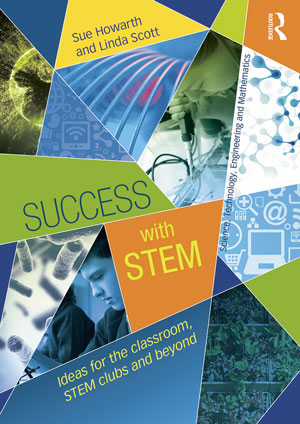Success with STEM: Ideas for the classroom, STEM clubs and beyond, by Sue Howarth and Linda Scott Inspire article
Success with STEM: Ideas for the classroom, STEM clubs and beyond is an excellent resource, brimming with ideas to support teachers of science, technology, engineering and maths (STEM).

Authored by two science education lecturers with significant experience in teaching and professional development, the book is designed to inform and enthuse both experienced and newly qualified teachers, giving guidance and explanations of initiatives that engage students and teachers in a more positive learning experience.
The book is divided into 11 chapters plus a glossary, and an extensive range of figures and tables supports each topic. Success with STEM also describes real-life examples of successful projects in schools that have supported both formal and informal STEM education – hence the title referring to the classroom and beyond. Although the book starts in the context of the British national curriculum and the needs-driven STEM agenda in the UK, it expands to encompass international ideas, and is a useful text for STEM teachers no matter where they are based.
The 5Es approach is advocated in the chapter on making lessons ‘buzz’: enrich, enhance, engage, experience, enjoy! Authors Sue Howarth and Linda Scott acknowledge that it is not necessary to have all of these in every lesson but they illustrate ways in which one or more of them can be incorporated using everyday examples, current issues, case studies or project work. They go on to describe ways in which teachers can provide opportunities for students beyond the classroom, from work in the school grounds and with the local community, including site visits, to more formally in competitions, fairs and festivals. They give comprehensive lists of examples of activities – not just for students but also for teachers in the context of continuing professional development.
There is a chapter on encouraging STEM careers, but one important point made early in the text is that while not all students will engage with STEM, all students should have some scientific literacy and an awareness of the role of science in modern society. If students take nothing else from compulsory curriculum subjects, they should leave with transferable skills such as communication, problem-solving and literacy, and an appreciation of STEM, which provides opportunities for the development of such skills.
Needless to say, funding can be an issue and the authors provide advice on sources of funding as well as free resources. Chapter 9 includes some ten pages of website links and advice on social media such as Twitter.
Howarth and Scott give advice on setting up a STEM club in school as well as ways to enhance existing clubs and increase involvement with competitions, fairs and festivals. Throughout the text, it is obvious that the authors are sharing actual experiences rather than writing theoretically. Key information on health, safety and legal issues is given in a factual way – again with lists of resources that can help teachers navigate these highly important areas.
The book concludes with ideas from international projects and an ‘ideas bank’ for all projects. This book is a valuable resource, easy to read and a fountain of information. It is highly recommended for all teachers.
Details:
Publisher: Routledge
Publication year: 2014
ISBN: 978-0-415-82289





